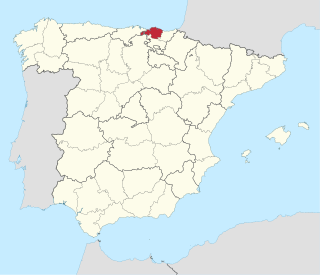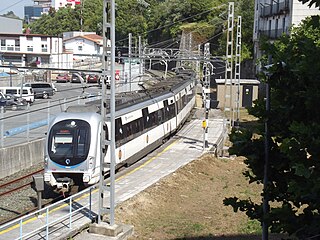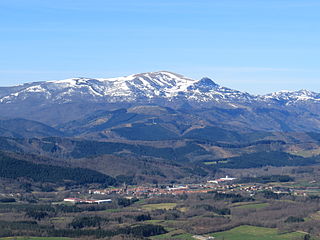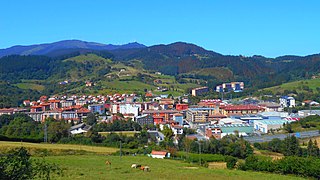
Biscay or Bizkaia, is a province of the Basque Autonomous Community, heir of the ancient Lordship of Biscay, lying on the south shore of the eponymous bay. The capital and largest city is Bilbao.

Euskotren Trena, formerly known just as Euskotren is a commuter, inter-city and urban transit train-operating company that operates local and inter-city passenger services in the provinces of Biscay and Gipuzkoa, in the Basque Country, Spain. It is one of the four commercial brands under which Euskotren operates, as a public company managed by the Basque government. The entire 181.1-kilometre (112.5 mi) network uses 1,000 mm narrow gauge rail tracks which have been owned by the Basque Government since their transferral from the Spanish government; the rail tracks and stations were part of the FEVE network until its transferral. Euskotren Trena also operates the Donostia/San Sebastián metro under the brand Metro Donostialdea.

Garai is an elizate, town and municipality located in the province of Biscay, in the Basque Country, Spain. Garai is part of the comarca of Durangaldea and has a population of 318 inhabitants as of 2009 according to the Spanish National Statistics Institute.

Eibar is a city and municipality within the province of Gipuzkoa, in the Basque Country of Spain. It is the capital of the eskualde / comarca of Debabarrena.

Gipuzkoa is a province of Spain and a historical territory of the autonomous community of the Basque Country. Its capital city is Donostia-San Sebastián. Gipuzkoa shares borders with the French department of Pyrénées-Atlantiques at the northeast, with the province and autonomous community of Navarre at east, Biscay at west, Álava at southwest and the Bay of Biscay to its north. It is located at the easternmost extreme of the Cantabric Sea, in the Bay of Biscay. It has 66 kilometres of coast land.

Dima is a town and municipality of the province of Biscay, in the Basque Country, Spain. Dima is part of the comarca of Arratia-Nerbioi and had a population of 1,313 inhabitants in 2010 according to the Spanish National Statistics Institute.

Elorrio is a town and a municipality located in the eastern part of the province of Biscay, in the Basque Country, in northern Spain. As of 2017, it has a population of 7,307 inhabitants. It covers an area of 37.20 square kilometers and it has a population density of 193.58 people per square kilometer. It holds the medieval title of Most Loyal and Noble Villa.

Izurtza is an elizate, town and municipality located in the province of Biscay, in the Basque Country, Spain. Izurtza is part of the comarca of Durangaldea and has a population of 270 inhabitants as of 2010 and according to the Spanish National Statistics Institute.

Mallabia is an elizate, town and municipality located in the province of Biscay, in the Basque Country, northern Spain. Mallabia is part of the comarca of Durangaldea and has a population of 1.135 inhabitants as of 2006 and according to the Spanish National Statistics Institute.

Mañaria is an elizate, town and municipality located in the province of Biscay, in the Basque Country, Spain. Mañaria is part of the comarca of Durangaldea and has a population of 459 inhabitants as of 2006 according to the Spanish National Statistics Institute.

Otxandio is a town and municipality located in the province of Biscay, in the Basque autonomous community, Spain. Otxandio is part of the comarca of Durangaldea and has a population of 1,269 inhabitants as of 2010 according to the Spanish National Statistics Institute.

Zaldibar is an elizate, town and municipality located in the province of Biscay, in the Basque Country, Spain. Zaldibar is part of the comarca of Durangaldea and has a population of 3,043 inhabitants as of 2019 and according to the Spanish National Statistics Institute.

Lea-Artibai is an eskualdea/comarca of the province of Biscay (Bizkaia), in the Basque Country, Spain. Lea-Artibai is the heir of the historical merindad of Markina, which was one of the merindades of Biscay. Currently, Lea-Artibai is one of the seven comarcas that compose the province. Its capital city is Markina-Xemein.

Durangaldea is a comarca of Biscay located in the Basque Country, Spain. It is one of the seven eskualdeak/comarcas or regions that compose the province of Biscay. The capital city of Durangaldea is Durango.
The General Assemblies is the name of the legislative body (legislature) of the Spanish Basque territories of Biscay, Gipuzkoa, Alava and Navarre, and the elected assemblies to which the Government of each territory is responsible. The northern, French Basque Country, had its own regional assemblies until the Napoleonic period.

The Lordship of Biscay was a region under feudal rule in the region of Biscay in the Iberian Peninsula between c.1040 and 1876, ruled by a political figure known as the Lord of Biscay. One of the Basque señoríos, it was a territory with its own political organization, with its own naval ensign, consulate in Bruges and customs offices in Balmaseda and Urduña, from the 11th century until 1876, when the Juntas Generales were abolished. Since 1379, when John I of Castile became the Lord of Biscay, the lordship was integrated into the Crown of Castile, and eventually the Kingdom of Spain.

Bilbao-Atxuri is a former terminal railway station in Bilbao, Basque Country (Spain). It served as the terminus station for the commuter rail trains of Euskotren Trena lines to Durango, Bermeo, Eibar and Donostia for over one hundred years.

The County of Durango, also known as Land of Durango and Merindad of Durango, was the ancient political administration of the territory that is now known as Durangaldea, in the Basque region of Biscay. This political administration included all the towns and elizates that existed within its territory. The elizates were all governed by the Foral law, while the towns had their own law. The county of Durango was a vassal state of the Kingdom of Pamplona, and in the 13th century it became a constituent part of the Lordship of Biscay. It has been part of the territory of Biscay since then. Its capital city was the town of Durango.
In the run up to the 2019 Spanish local elections, various organisations carried out opinion polling to gauge voting intention in local entities in Spain. Results of such polls for municipalities and the three foral deputations in the Basque Country are displayed in this article. The date range for these opinion polls is from the previous local elections, held on 24 May 2015, to the day the next elections were held, on 26 May 2019.
In the run up to the 2015 Spanish local elections, various organisations carried out opinion polling to gauge voting intention in local entities in Spain. Results of such polls for municipalities and the three foral deputations in the Basque Country are displayed in this article. The date range for these opinion polls is from the previous local elections, held on 22 May 2011, to the day the next elections were held, on 24 May 2015.





















